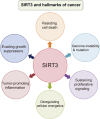Sirtuin-3 (SIRT3), a therapeutic target with oncogenic and tumor-suppressive function in cancer
- PMID: 24503539
- PMCID: PMC3944233
- DOI: 10.1038/cddis.2014.14
Sirtuin-3 (SIRT3), a therapeutic target with oncogenic and tumor-suppressive function in cancer
Abstract
Sirtuin-3 (SIRT3), a major mitochondria NAD+-dependent deacetylase, may target mitochondrial proteins for lysine deacetylation and also regulate cellular functions. And, SIRT3 is an emerging instrumental regulator of the mitochondrial adaptive response to stress, such as metabolic reprogramming and antioxidant defense mechanisms. Accumulating evidence has recently demonstrated that SIRT3 may function as either oncogene or tumor suppressor on influencing cell death by targeting a series of key modulators and their relevant pathways in cancer. Thus, in this review, we present the structure, transcriptional regulation, and posttranslational modifications of SIRT3. Subsequently, we focus on highlighting the Janus role of SIRT3 with oncogenic or tumor-suppressive function in cancer, which may provide more new clues for exploring SIRT3 as a therapeutic target for drug discovery.
Figures




Similar articles
-
Context-dependent role of SIRT3 in cancer.Trends Pharmacol Sci. 2024 Feb;45(2):173-190. doi: 10.1016/j.tips.2023.12.005. Epub 2024 Jan 19. Trends Pharmacol Sci. 2024. PMID: 38242748 Review.
-
Mitochondrial Sirtuin 3: New emerging biological function and therapeutic target.Theranostics. 2020 Jul 9;10(18):8315-8342. doi: 10.7150/thno.45922. eCollection 2020. Theranostics. 2020. PMID: 32724473 Free PMC article. Review.
-
CDK1-Mediated SIRT3 Activation Enhances Mitochondrial Function and Tumor Radioresistance.Mol Cancer Ther. 2015 Sep;14(9):2090-102. doi: 10.1158/1535-7163.MCT-15-0017. Epub 2015 Jul 3. Mol Cancer Ther. 2015. PMID: 26141949 Free PMC article.
-
Advances in characterization of SIRT3 deacetylation targets in mitochondrial function.Biochimie. 2020 Dec;179:1-13. doi: 10.1016/j.biochi.2020.08.021. Epub 2020 Sep 6. Biochimie. 2020. PMID: 32898647 Review.
-
Identification of Sirtuin 3, a mitochondrial protein deacetylase, as a new contributor to tamoxifen resistance in breast cancer cells.Biochem Pharmacol. 2013 Sep 15;86(6):726-33. doi: 10.1016/j.bcp.2013.06.032. Epub 2013 Jul 12. Biochem Pharmacol. 2013. PMID: 23856293
Cited by
-
Sirt3 enhances glioma cell viability by stabilizing Ku70-BAX interaction.Onco Targets Ther. 2018 Oct 29;11:7559-7567. doi: 10.2147/OTT.S172672. eCollection 2018. Onco Targets Ther. 2018. PMID: 30464504 Free PMC article.
-
Targeting Inflammatory-Mitochondrial Response in Major Depression: Current Evidence and Further Challenges.Oxid Med Cell Longev. 2020 Apr 14;2020:2972968. doi: 10.1155/2020/2972968. eCollection 2020. Oxid Med Cell Longev. 2020. PMID: 32351669 Free PMC article. Review.
-
Mitochondrial energy metabolism and signalling in human glioblastoma cell lines with different PTEN gene status.J Bioenerg Biomembr. 2018 Feb;50(1):33-52. doi: 10.1007/s10863-017-9737-5. Epub 2017 Dec 6. J Bioenerg Biomembr. 2018. PMID: 29209894
-
Gene Expression Profiling Reveals Fundamental Sex-Specific Differences in SIRT3-Mediated Redox and Metabolic Signaling in Mouse Embryonic Fibroblasts.Int J Mol Sci. 2024 Mar 30;25(7):3868. doi: 10.3390/ijms25073868. Int J Mol Sci. 2024. PMID: 38612678 Free PMC article.
-
Sirtuin family in lung adenocarcinoma.Discov Oncol. 2025 Jul 23;16(1):1398. doi: 10.1007/s12672-025-03217-4. Discov Oncol. 2025. PMID: 40702355 Free PMC article. Review.
References
-
- Schlicker C, Gertz M, Papatheodorou P, Kachholz B, Becker CF, Steegborn C. Substrates and regulation mechanisms for the human mito- chondrial sirtuins Sirt3 and Sirt5. J Mol Biol. 2008;382:790–801. - PubMed
Publication types
MeSH terms
Substances
LinkOut - more resources
Full Text Sources
Other Literature Sources

